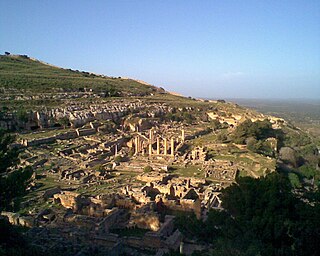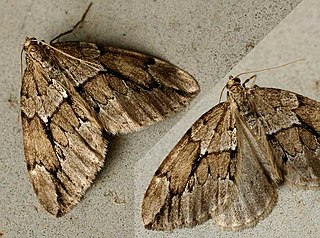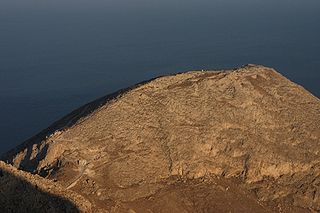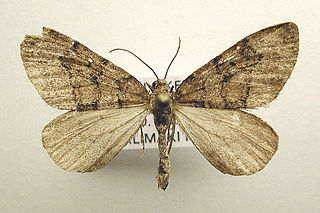
Santorini, officially Thira and classical Greek Thera, is an island in the southern Aegean Sea, about 200 km (120 mi) southeast from the Greek mainland. It is the largest island of a small circular archipelago, which bears the same name and is the remnant of a caldera. It forms the southernmost member of the Cyclades group of islands, with an area of approximately 73 km2 (28 sq mi) and a 2011 census population of 15,550. The municipality of Santorini includes the inhabited islands of Santorini and Therasia, as well as the uninhabited islands of Nea Kameni, Palaia Kameni, Aspronisi and Christiana. The total land area is 90.623 km2 (34.990 sq mi). Santorini is part of the Thira regional unit.

The Minoan civilization was a Bronze Age Aegean civilization on the island of Crete and other Aegean Islands, whose earliest beginnings were from c. 3500 BC, with the complex urban civilization beginning around 2000 BC, and then declining from c. 1450 BC until it ended around 1100 BC, during the early Greek Dark Ages, part of a wider bronze age collapse around the Mediterranean. It represents the first advanced civilization in Europe, leaving behind a number of massive building complexes, sophisticated art, and writing systems. Its economy benefited from a network of trade around much of the Mediterranean.

Cyrene or Kyrene, was an ancient Greek and later Roman city near present-day Shahhat, Libya. It was the oldest and most important of the five Greek cities, known as the pentapoleis, in the region. It gave eastern Libya the classical name Cyrenaica that it has retained to modern times. Located nearby is the ancient Necropolis of Cyrene. The traditional founder of the city was Battus the Lacedemonian, though the exact relationship between the fledgling city and other cities has led historians to question that narrative. Particularly, the idea that Thera was the sole "mother city" is disputed; and the relationship with other cities, such as Sparta and Samian merchants, is unclear.

The role of Greek Buddhist monks in the development of the Buddhist faith under the patronage of Emperor Ashoka around 260 BCE and subsequently during the reign of the Indo-Greek king Menander is described in the Mahavamsa, an important non-canonical Theravada Buddhist historical text compiled in Sri Lanka in the 6th century in the Pali language.

The juniper carpet is a moth of the family Geometridae. The species was first described by Carl Linnaeus in his 1758 10th edition of Systema Naturae. It is found throughout Europe and the Near East, but is rather uncommon and locally distributed, mainly due to its very specific larval food plant.

Śāriputra was one of the top disciples of the Buddha. He is considered the first of the Buddha's two chief male disciples, together with Maudgalyāyana. Śāriputra had a key leadership role in the ministry of the Buddha and is considered in many Buddhist schools to have been important in the development of the Buddhist Abhidharma. He frequently appears in Mahayana sutras, and in some sutras, is used as a counterpoint to represent the Hinayana school of Buddhism.

The spruce carpet is a moth in the family Geometridae. The species was first described by Alfred Jefferis Turner in 1925. It is a double-brooded species, meaning it has two broods in one year. Its wings are coloured with different shades of grey, but the spring brood tends to have more brown colours.

The Minoan eruption was a catastrophic volcanic eruption that devastated the Aegean island of Thera circa 1600 BCE. It destroyed the Minoan settlement at Akrotiri, as well as communities and agricultural areas on nearby islands and the coast of Crete with subsequent earthquakes and tsunamis. With a VEI magnitude between 6 and 7, resulting in an ejection of approximately 60 km3 (14 cu mi) of dense-rock equivalent (DRE), the eruption was one of the largest volcanic events on Earth in human history. Since tephra from the Minoan eruption serves as a marker horizon in nearly all archaeological sites in the Eastern Mediterranean, its precise date is of high importance and has been fiercely debated among archaeologists and volcanologists for decades, without coming to a definite conclusion.

Nyanaponika Thera or Nyanaponika Mahathera was a German-born Theravada Buddhist monk and scholar who, after ordaining in Sri Lanka, later became the co-founder of the Buddhist Publication Society and author of numerous seminal books and articles on Theravada Buddhism. He mentored and taught a whole generation of Western Buddhist leaders such as Bhikkhu Bodhi.

Ñāṇavīra Thera was an English Theravāda Buddhist monk, ordained in 1950 in Sri Lanka. He is known as the author of Notes on Dhamma, which were later published by Path Press together with his letters in one volume titled Clearing the Path.

Thera variata, the spruce carpet, is a moth of the family Geometridae. It is found throughout Europe, North Asia and Japan. The common name spruce carpet is also used when referring to Thera britannica.

Thera firmata, the pine carpet, is a moth of the family Geometridae. It is found throughout Europe, Anatolia and countries bordering the Caucasus Mountains.

Thera is a genus of moths of the family Geometridae erected by James Francis Stephens in 1831.

Thera obeliscata, the grey pine carpet, is a moth of the family Geometridae. It is found throughout north and central Europe and east across the Palearctic to Siberia, and south to the Caucasus and Transcaucasia. In the Alps it can be found at an altitude of over 1500 metres.

Ancient Thera is the name of an ancient perfectly round volcano island now known as Santorini. It was named after the mythical ruler of the island, Theras, and is known to have been inhabited by Greek Minoans as early as the 15th century BC when the volcano erupted resulting in a significant change to the shape of the island and killing many of the Minoan inhabitants. Starting in 1895, Friedrich Hiller von Gaertringen systematically investigated the city until 1904. Later excavations by N. Zapheiropoulos between 1961 and 1982, under the auspices of the Archaeological Society of Athens, unearthed the city's necropolis in Sellada. Findings from these excavations are on exhibit at the archaeological museum in Fira. Excavation work was again taken up between 1990 and 1994 under the leadership of Wolfram Hoepfner of the Free University of Berlin and resulted in a more precise understanding of the history of the southern Aegean.

The London Buddhist Vihara is one of the main Theravada Buddhist temples in the United Kingdom. The Vihara was the first Sri Lankan Buddhist monastery to be established outside Asia.

Thera cognata, the chestnut-coloured carpet or Durham juniper moth, is a moth of the family Geometridae. The species was first described by Carl Peter Thunberg in 1792. It is found in Europe, Asia Minor, the Caucasus and Transcaucasus.

Thera otisi is a species of geometrid moth in the family Geometridae. It is found in North America.
Thera contractata, known generally as the contracted spanworm or evergreen spanworm, is a species of geometrid moth in the family Geometridae. It is found in North America.

Thera latens is a species of moth in the family Geometridae first described by William Barnes and James Halliday McDunnough in 1917. It is found in North America.


















